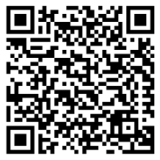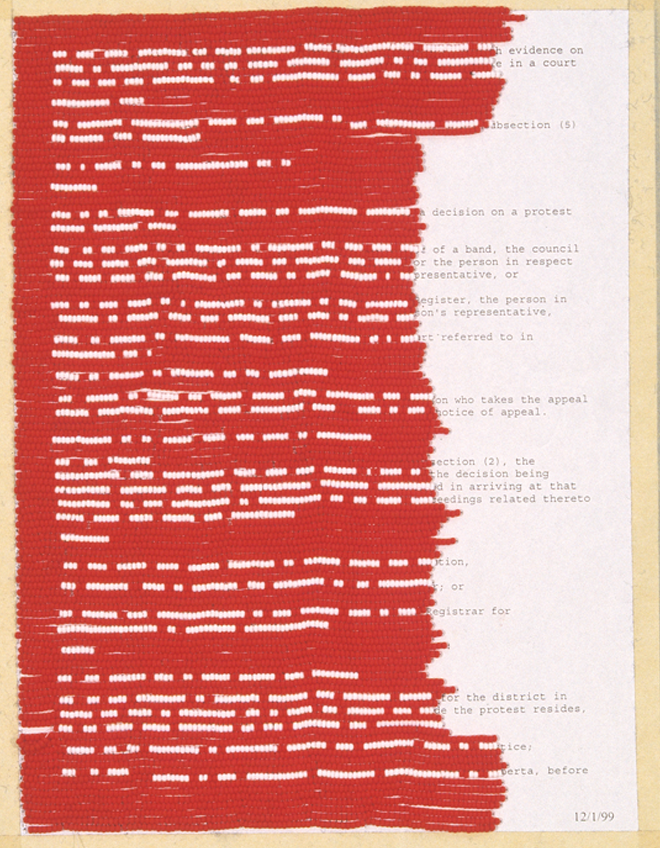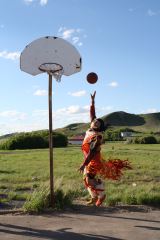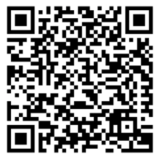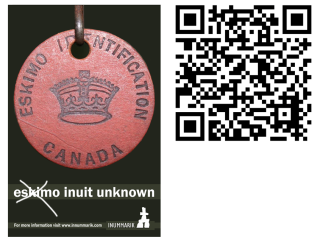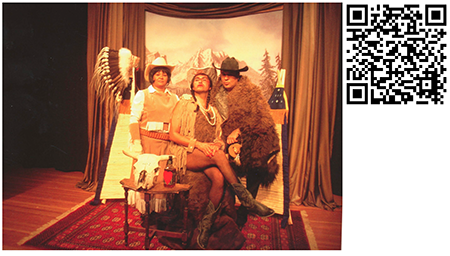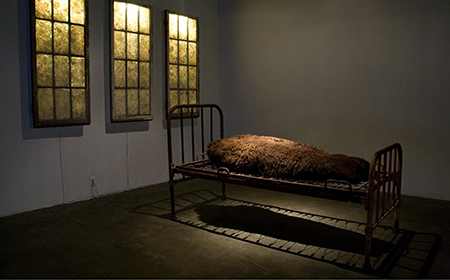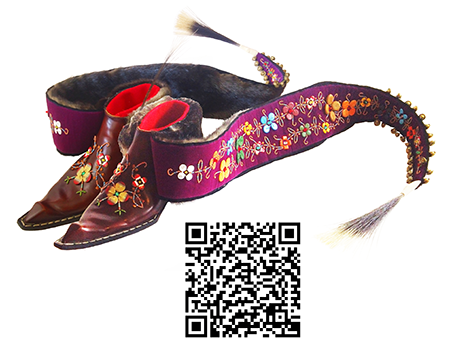Stay safe and stay informed! Consult the Faculty of Education's COVID-19 FAQ Page!
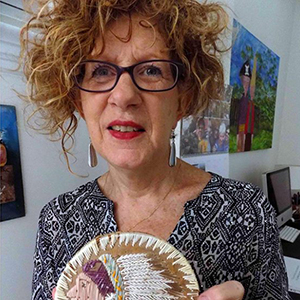 Lori Beavis is a curator, art educator and art historian living and working in Tiohtià:ke/ Montreal. Identifying as being of Michi Sagiig (Mississauga) Anishinaabe and Irish-Welsh descent, she is a band member of Hiawatha First Nation at Rice Lake, Ontario. Her PhD (Concordia, Art Education 2016) investigated the intersections between life long art experiences and cultural identity in the lives of four contemporary Indigenous women artists. Her curatorial work, art practice and research, articulates narrative and memory in the context of family and cultural history, and a reflects on cultural identity, art education and self-representation. Her curatorial project, co-curated with Rhonda L. Meier, The Rebel Yells; Dress and Political Re-dress in Contemporary Indigenous Art (2015) brought eleven artists from across Canada to Montreal to further the conversation on art, identity and self-representation. In 2016, she curated recent work by Shelley Niro at The Northern Front Studio, Whitehorse, YK. In 2019, Beavis will curate solo exhibitions with Shelley Niro at the Art Gallery of Peterborough and with Barry Ace at FOFA Gallery, Montreal, and a group exhibition, In/Visible: the body as Reflective Site, a co-curatorial project with Maria Ezcurra and Natasha Reid at the McClure Gallery, Westmount. At this time Beavis serves on the Aboriginal Curatorial Collective’s Tiohtià:ke Project Advisory Committee, and the Musée d'art contemporain de Montréal Art Acquisitions Committee as the representative of the ACC.
Lori Beavis is a curator, art educator and art historian living and working in Tiohtià:ke/ Montreal. Identifying as being of Michi Sagiig (Mississauga) Anishinaabe and Irish-Welsh descent, she is a band member of Hiawatha First Nation at Rice Lake, Ontario. Her PhD (Concordia, Art Education 2016) investigated the intersections between life long art experiences and cultural identity in the lives of four contemporary Indigenous women artists. Her curatorial work, art practice and research, articulates narrative and memory in the context of family and cultural history, and a reflects on cultural identity, art education and self-representation. Her curatorial project, co-curated with Rhonda L. Meier, The Rebel Yells; Dress and Political Re-dress in Contemporary Indigenous Art (2015) brought eleven artists from across Canada to Montreal to further the conversation on art, identity and self-representation. In 2016, she curated recent work by Shelley Niro at The Northern Front Studio, Whitehorse, YK. In 2019, Beavis will curate solo exhibitions with Shelley Niro at the Art Gallery of Peterborough and with Barry Ace at FOFA Gallery, Montreal, and a group exhibition, In/Visible: the body as Reflective Site, a co-curatorial project with Maria Ezcurra and Natasha Reid at the McClure Gallery, Westmount. At this time Beavis serves on the Aboriginal Curatorial Collective’s Tiohtià:ke Project Advisory Committee, and the Musée d'art contemporain de Montréal Art Acquisitions Committee as the representative of the ACC.
Altars for the Day of the Dead
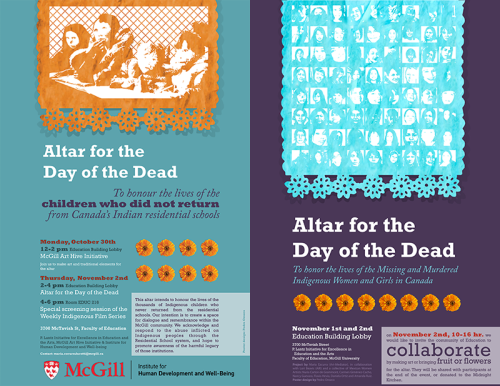
The Day of the Dead (Día de Muertos) is a festive and sacred time in Mexico and other Latin American countries. This day, the souls of the dead are welcomed back, joined with the living and becoming a celebration of life. Significant objects are placed as gifts to the visiting souls in ofrendas: the altars for the children are set on the eve of October 31st with sweets, fruits and white flowers, while the eve of November 1st is the time to honor the adults with cempasúchil (marigold flower), spicy food, alcoholic drinks and cigarettes. Although many elements of Catholicism were incorporated into the ofrenda after the Spanish conquest, it is considered mostly an Indigenous tradition.
As a group women artists (conformed by both Canadian and Mexican women, as well as by Indigenous descent women from both Latin and North America), we want to offer this ofrenda to the hundreds of Indigenous women and girls that have been murdered in Canada, and the rest of the continent, over the past decades. We are also considering the many missing women in this altar, which purpose is remembrance: we acknowledge that not being physically present isn’t the same as being gone.
With this ofrenda installed at the Faculty of Education, we want to acknowledge the traditional territory of the Kanien’kehá:ka people where we stand today, celebrating our ancestors and sharing diverse Indigenous culture with the community of McGill (the altar will have elements from Indigenous communities from both Mexico and Canada). Moreover, we want to honour the lives of all the Indigenous women and girls that have gone missing or have been murdered in Canada as a way to bring awareness to the widespread violence against Indigenous women and girls, and gender-based violence in general.
Note: The community of Education was invited to collaborate by bringing food or flowers for the altar. They also came to the Art Hive where we made “punched” paper, Cempasuchil flowers, and many more traditional elements for the ofrenda.
The project was led by Maria Ezcurra (Art Mediator), in collaboration with Lori Beavis (Artist-in-Residence) and a collective of Mexican women artists: Nura Carton de Grammont, Carmen Giménez-Cacho, Nancy Guevara, Flavia Hevia, Daniela Ortiz and Amanda Ruiz.
Freire Cabinet Art Project
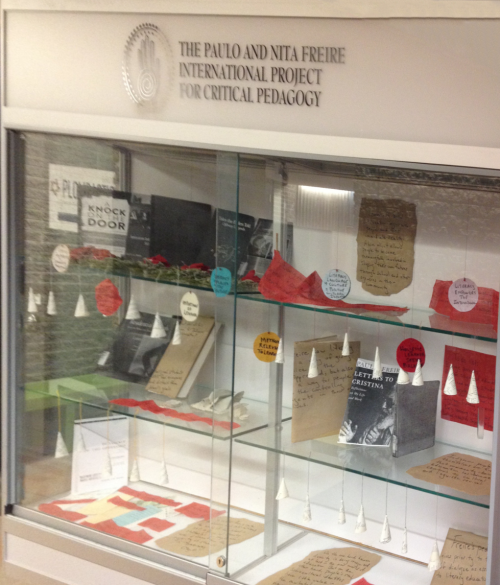 My objective in intervening in the Freire cabinet was to pose a number of questions. I have not specifically answered these questions in an academic manner but I have provided materials (book jackets, quotes and other bibliographic materials) to suggest a starting point for a discussion. I also made paper jingles (acknowledging Maria Huppfield) from old books hung from threads that indicate the four directions.
My objective in intervening in the Freire cabinet was to pose a number of questions. I have not specifically answered these questions in an academic manner but I have provided materials (book jackets, quotes and other bibliographic materials) to suggest a starting point for a discussion. I also made paper jingles (acknowledging Maria Huppfield) from old books hung from threads that indicate the four directions.
Is there a connection between Indigenous experiences and Freire?
Is there a connection between Freire and Indigenous experiences of Residential Schools?
What is literacy?
What does literacy look like in a Euro-western understanding and in Indigenous culture?
How does literacy impact/ limit community development?
What are the emblems of literacy? -> pens/ pencils/ books – signatures
What about literacy and the signed treaties? – Literacy/identity -> signatures versus dodems
What does cultural knowledge look like?
What is emblematic of an oral tradition?
Did the Residential Schools teach literacy?
What else did the Residential schools teach?
What did the Residential schools take away from the students?
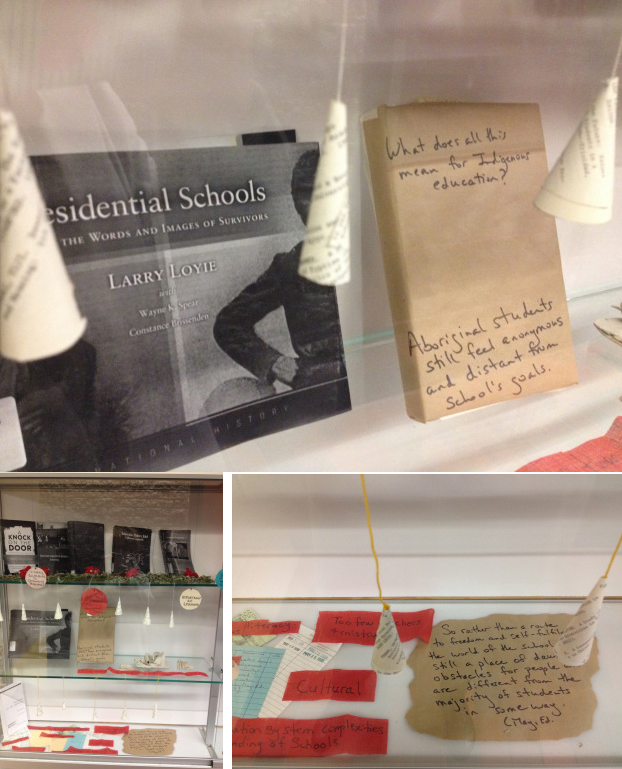
Presence: The Grandmothers
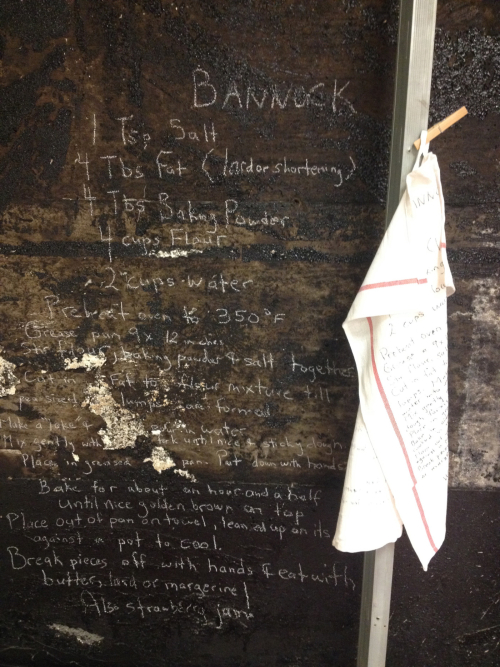 I have taken the idea of the grandmothers as holders of memories. The stones that heat the Ojibway sweat lodge are often named as grandfather of grandmother. In Anishinaabe culture the grandmothers are the knowledge holders of language, customs and beliefs.
I have taken the idea of the grandmothers as holders of memories. The stones that heat the Ojibway sweat lodge are often named as grandfather of grandmother. In Anishinaabe culture the grandmothers are the knowledge holders of language, customs and beliefs.
For this project I am thinking about the idea of the vestiges or remains of our heritages and of our identity and through this to how we self-identify. I also want to examine the idea of presence. How do we know or what do we know about the past from what we can see today, in the present? What did our grandmother tell us about our family heritage? How do we hold the knowledge of the past and keep the vestiges of what went before? Whose presence guides or informs us? What are the vestiges of our past family generations – in our lives? on the land?
To help answer some of these questions and establish a presence and an on-going presence (hidden or partially seen/known of). I am asking people to share memories of their grandmothers, as these memories are usually very tangible and immediate. One way of coming to these memories is by asking people to use their memories of cooking with their grandmothers as a way to enter into knowing who we are. I have started with recipes that I remember from my life with my grandmother, Laura Hannah Cowie Jones, a Mississauga woman from Rice Lake Ontario.
I am asking people to come and join me at the Art Hive and bring one of their grandmother’s recipes. This might be a recipe that they made with their grandmother or one that she made for you. At the same time we will share the memories of our grandmothers and of cooking with her. The recipes will be written on the wall of the studio space.
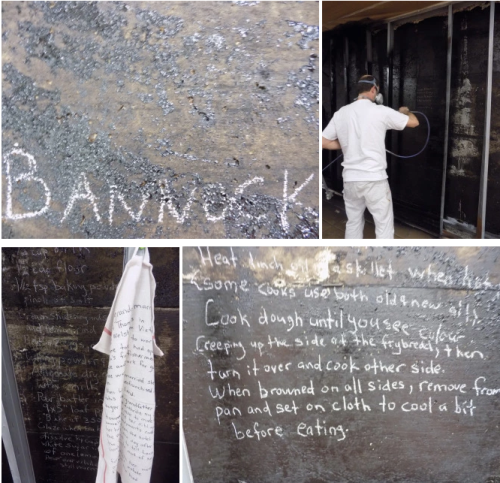
In time the wall will be covered up but I think this adds another layer to the idea of presence and ultimately, identities and how they move and change over time – but the knowledge that your grandmother gave you about who you are stays with you and there is always some hidden presence left.
zhigwe/aim
zhigwe / aim is a multi-week project that seeks to introduce contemporary Indigenous artists and their art work to the students, faculty and staff.
The word zhigwe (su-i (flat i)-gwe) is the Anishinaabe word for aim. It is an appropriate choice on two levels, the first being that in the act of aiming your smartphone at the QR code, information will be revealed about the image. The second is, the aim of this project is to ask – Can learning about the social and political issues these Indigenous artists are examining educate us as educators? Can knowledge of contemporary artists and their art contribute to reconciliation? Will this knowledge help us move forward in reconciliation and build “capacity for intercultural understanding, empathy, and mutual respect”? (TRC Calls for Action, (2015) p. 7, #63.iii)
Art by artists Shelley Niro, Adrian Stimson, Barry Pottle, Lori Blondeau, Kent Monkman, Barry Ace, David Garneau, and Nadia Myre has been chosen because they are all working with material and subjects that create awareness of the Indigenous experience in Canada. Their work is also very accessible in terms of the subject matter and eye-catching images. The viewer may also have an emotional response to the work. Art is often a way to say the unsayable – it can tell stories about family histories, knowledge and experiences and it can often open the space to have a public discussion about difficult and challenging subjects.
These images also speak to the notion of self-representation and this is important because the artists have a story to tell about Canada as a colonial space from an Indigenous perspective. The stories are important and may in some ways act as a form of activism as the information is dispersed.
The images of the art works are displayed alongside a QR Code (Quick Response Code). When the square of black & white code is scanned further information about the artist and the object will be available. The code can be captured with your smartphone camera. To be able to read QR codes, you need to download a free QR Reader app, such as Quick Scan.
Nadia Myre, Indian Act (2000-02)
Image used by permission of the artist, Nadia Myre and Art Mur
|
David Garneau, Hoop Dancers (2013) Image courtesy of the artist
|
Lori Blondeau and Adrian Stimson, Putting the Wild back into the West (2004)
|
|
Lori Blondeau, Lonely Surfer Squaw (1997) Image used by permission of the artist |
Barry Ace, Nigik Makizinan - Otter Moccasins (2014) Image courtesy of the artist |
